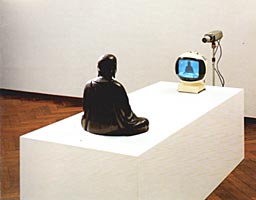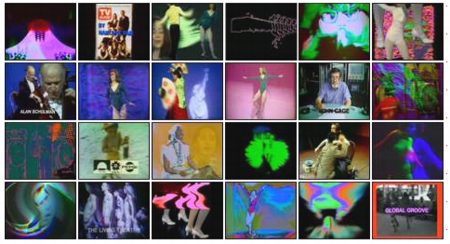
I used to live downstairs from Nam June Paik. I was too starstruck to ever talk with him at length, but we had friendly chats when we'd see each other in the stairway of our Little Italy loft building.
Once, I did manage to tell him how much I admired his pieces in the John Cage show that was going on over at the Guggenheim SoHo ["Rolywholyover: A Circus," still one of the most brilliant and exciting museum exhibitions I've ever seen. Incredible catalogue, too.] My favorite was and is TV Buddha, a nearly perfect conceptualized work comprised of a carved Buddha statue , a video camera, and a television. The statue sits enlightened and silent, endlessly watching itself on the screen.
TV Buddha is made even better by the allegedly offhand way it was created, as "wall filler" for a 1974 gallery show in New York, though I wouldn't be surprised if Paik was just being reflexively modest when the work was praised.
He made many versions and variations on the TV Buddha theme over the years, and I'd also imagine it could come to feel like a zen trap, a polite rut, especially for an artist whose work betrays an abiding affection for baroque dadaism and psychedelic media cacophony. TV Buddha feels like a kind of contemplative road less traveled.

The road Paik took instead, was the one he named, the Information Super-Highway, which was signalled by another seminal early piece, the 1973 TV show/control room happening/video art work, Global Groove. Produced with John Godfrey at WNET in New York, Global Groove is at once freakishly prescient and contemporary, and hilariously of its time.
It opens with the bold promise that we're living with right now: "This is a glimpse of the video landscape of tomorrow, when you will be able to switch to any TV station on the earth, and TV Guide will be as fat as the Manhattan telephone book." Which is promptly followed by a groove challenged pair of disco dancers and every psychedelic FX trick in the 1973 TV producer's book. It's at once funny and sad to realize Global Groove's aesthetic has become the lingua franca of Manhattan's public access TV world. Hell, it's probably the same mixing board Paik & Godfrey used.
Paik's TV sculptures and giant video walls which are so popular/populist with museums and lobby decorators feel like continuations of Global Groove's groove, but it doesn't scale. Paik foresaw our TV-webby mediascape and reveled in it; I just wish and wonder if somewhere in Paik's mature-to-late career, away from the bombastic over-commissions, there's some underappreciated body of work that might enlighten us as to how we can live in this worldwide web.
See a photo of the first TV Buddha and watch the first few minutes of Global Groove on Mediakunstnetz.de [mkz]
There's some Paik-related material on YouTube, but not as much as you'd hope [youtube]












